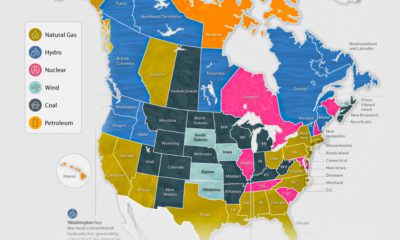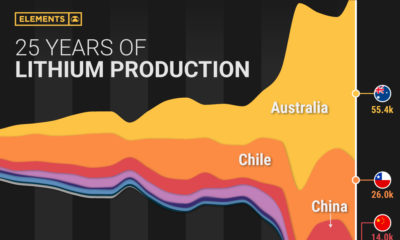Over the last 50 years, the world has seen a colossal increase in energy consumption—and with the ongoing transition to renewable energy, it’s interesting to look at how these sources of energy have been evolving over time. While some countries continue to rely heavily on fossil fuels like oil, coal, and natural gas, others have integrated alternative energy sources into their mix. This visualization comes to us from Brian Moore and it charts the evolution of energy consumption in the 64 countries that have data available for all of the last 50 years.
Tera-What? The Most Prominent Sources of Energy (2009-2018)
First, let’s take a look at which sources have produced the most energy over the last decade of data. Energy consumption is measured in terawatt-hours (TWh)—a unit of energy equal to outputting one trillion watts for an hour. Looking at this data, it’s clear that fossil fuels have been used much more than alternative sources. A deeper dive into the topic helps explain why.
Fossil Fuels: What the Data Shows
As the predominant source of energy, fossil fuels collectively accounted for a massive 86.2% of total energy consumption over 2009-2018, or roughly 1.2 million TWh. If you’re wondering, that’s enough to power the equivalent of 109 billion U.S. homes with electricity for a year. Among fossil fuel sources, oil emerges as the clear leader, responsible for 34.3% or 509,800 TWh of energy consumption over 2009-2018. Apart from being the primary fuel for transportation throughout history, oil remains relatively affordable—making it an easy choice for producers and consumers alike. Closely following oil is coal, which countries rely on for its abundance, low costs, and low infrastructure requirements. Over the last decade of data, 29.2% of total energy came from coal, amounting to a substantial 434,300 TWh. As a cleaner alternative to coal, natural gas has increased in popularity. Gas accounted for 22.8% or 339,300 TWh of energy consumed between 2009-2018, mainly attributed to its ample supply and affordability.
What About Renewables?
Only 13.8% of energy consumption over 2009-2018 came from renewable or alternative sources of energy, and hydropower accounts for nearly half of it. Why has the use of environmentally-friendly energy sources been so low?
Setting up alternative power plants—especially wind, solar, and nuclear—requires significant capital investment, while facing competition from cheaper and more convenient fossil fuels. The barriers to adopting renewable energy have been weakening, but still remain quite high for low-income countries.
Wind and solar energy were responsible for a mere 1.7% of energy consumption. Compared to fossil fuels like oil and coal, this percentage seems even more minuscule than it does on its own—mainly attributable to the high costs traditionally associated with wind and solar energy.
The Top 10 Countries Relying on Fossil Fuels
Fossil fuels have been the predominant source of energy over the years. After all, 43 of these 64 countries sourced more than 80% of their energy from fossil fuels over 2009-2018. Here are the ones that come out on top: Although it is startling to see that several countries were 100% reliant on fossil fuels, it comes as no surprise that these are countries with abundant reserves of oil or natural gas. Not only are fossil fuels central to certain economies in Middle Eastern and North African (MENA), but they also remain highly affordable for consumers in these places. On a broader scale, developing and low-income countries are heavily dependent on fossil fuels such as coal for access to cheap electricity and ease of installation.
The Top 10 Countries Using Alternative Energy Sources
The transition to alternative energy sources has been welcomed by many countries, but only a few have prioritized its adoption in the energy mix. Here’s a look at the top 10: Iceland is the only country to have sourced over 80% of its energy from alternative sources over 2009-2018. In general, developed European countries are leading the charge—with Iceland, Norway, Sweden, Switzerland, and France making the top five. The dominance of hydropower is notable, and so is the lack of wind and solar energy sources. Denmark had the highest percentage of wind energy in its mix, with 14.5%, whereas Italy had the highest percentage of solar, with just 2.4%. It should be kept in mind that this percentage does not account for population differences. For example, although Italy boasted the highest percentage of solar in its energy mix with 2.4%, China consumed the most amount of energy from solar sources—despite it accounting for only 0.3% of total Chinese energy consumption. Nevertheless, the costs of solar and wind energy have been falling continuously, and the potential for growth in the renewable energy sector is higher than ever.
The Transition to Renewables: Are We On Track?
Since the Industrial Revolution, fossil fuels have been the primary source of energy worldwide. More recently, the use of renewable energy sources has increased, but not substantially enough. This predominant reliance on fossil fuels is not doing the transition to renewable energy any favors, but it shines a light on the massive untapped potential for alternative energies, especially in the developing world. With the prices of renewable energy at record lows and increasing investment flows, the next decade will be a defining one for the global transition to clean energy. Correction: A modified version of Brian Moore’s visualization was previous published here. We’ve since updated it to the original design. on
#1: High Reliability
Nuclear power plants run 24/7 and are the most reliable source of sustainable energy. Nuclear electricity generation remains steady around the clock throughout the day, week, and year. Meanwhile, daily solar generation peaks in the afternoon when electricity demand is usually lower, and wind generation depends on wind speeds.As the use of variable solar and wind power increases globally, nuclear offers a stable and reliable backbone for a clean electricity grid.
#2: Clean Electricity
Nuclear reactors use fission to generate electricity without any greenhouse gas (GHG) emissions.Consequently, nuclear power is the cleanest energy source on a lifecycle basis, measured in CO2-equivalent emissions per gigawatt-hour (GWh) of electricity produced by a power plant over its lifetime. The lifecycle emissions from a typical nuclear power plant are 273 times lower than coal and 163 times lower than natural gas. Furthermore, nuclear is relatively less resource-intensive, allowing for lower supply chain emissions than wind and solar plants.
#3: Stable Affordability
Although nuclear plants can be expensive to build, they are cost-competitive in the long run. Most nuclear plants have an initial lifetime of around 40 years, after which they can continue operating with approved lifetime extensions. Nuclear plants with lifetime extensions are the cheapest sources of electricity in the United States, and 88 of the country’s 92 reactors have received approvals for 20-year extensions. Additionally, according to the World Nuclear Association, nuclear plants are relatively less susceptible to fuel price volatility than natural gas plants, allowing for stable costs of electricity generation.
#4: Energy Efficiency
Nuclear’s high energy return on investment (EROI) exemplifies its exceptional efficiency. EROI measures how many units of energy are returned for every unit invested in building and running a power plant, over its lifetime. According to a 2018 study by Weissbach et al., nuclear’s EROI is 75 units, making it the most efficient energy source by some distance, with hydropower ranking second at 35 units.
#5: Sustainable Innovation
New, advanced reactor designs are bypassing many of the difficulties faced by traditional nuclear plants, making nuclear power more accessible.
Small Modular Reactors (SMRs) are much smaller than conventional reactors and are modular—meaning that their components can be transported and assembled in different locations. Microreactors are smaller than SMRs and are designed to provide electricity in remote and small market areas. They can also serve as backup power sources during emergencies.
These reactor designs offer several advantages, including lower initial capital costs, portability, and increased scalability.
A Nuclear-Powered Future
Nuclear power is making a remarkable comeback as countries work to achieve climate goals and ultimately, a state of energy utopia. Besides the 423 reactors in operation worldwide, another 56 reactors are under construction, and at least 69 more are planned for construction. Some nations, like Japan, have also reversed their attitudes toward nuclear power, embracing it as a clean and reliable energy source for the future. CanAlaska is a leading exploration company in the Athabasca Basin, the Earth’s richest uranium depository. Click here to learn more now. In part 3 of the Road to Energy Utopia series, we explore the unique properties of uranium, the fuel that powers nuclear reactors.





























